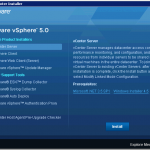Reading Time: 4 minutesObjective 1.1 – Install and Configure vCenter Server
See also this similar post: Objective 1.1 – Install and Configure vCenter Server and Objective 1.1 — Install and Configure vCenter Server.
Identify available vCenter Server editions (new in vSphere 5.x)
As in vSphere 4.x, the vCenter Server 5 editions are:
- vCenter Server Foundation: same limits of 4.x (max 3 hosts, no Orchestrator, no Linked mode)
- vCenter Server Essential: basically a Foundation edition to be used in the Essential and Essential+ bundles
- vCenter Server Standard: the full edition (with some limits only in the appliance version)
For the vCenter Server installation and deployment there are now two different options (in vSphere 4.x there was only the first one):
- install the vCenter Server on a Windows Server machine (physical or VM), see minimum requirements (and note that now Windows XP is no more supported)
- deploy of a virtual appliance (VA) based on SuSE Enterprise (no Windows license is required, but there are some limitations)
Deploy the vCenter Appliance (new in vSphere 5.x)
The deploy phase is similar to a usual VA: http://vmwire.com/2011/07/15/vsphere-vcenter-server-linux-virtual-appliance-quick-start-guide/
The blueprint does not specify also the configuration, but I suppose that could be required. See the vSphere Installation and Setup Guide (page 201) and vCenter Server and Host Management Guide (page 41).
For more info and a list of the VA limits see also: vCenter Server Virtual Appliance (vCSA)
Install vCenter Server into a virtual machine (same as vSphere 4.x)
See: http://vinfrastructure.it/vdesign/vmware-vcenter-server-physical-or-virtual/.
Size the vCenter Server database (similar as vSphere 4.x)
You can use the estimator included in vCenter Server (or download the excel from VMware site). I recommend to check how grow with the number of hosts, VMs and the statistical level:
Install additional vCenter Server components (new in vSphere 5.x)
In the vCenter DVDN there are the following packages:
- vCenter Server for Windows (that include also the Orchestrator)
- vSphere Client
- vSphere Web Client (server part for Windows)
- vSphere Update Manager
- ESXi Dump Collector
- Syslog Server
- Auto Deploy
- vSphere Authentication Proxy
Install/Remove vSphere Client plug-ins (same as vSphere 4.x)
Installation usually is done from the plug-in manager (but not always) or from an installation program or MSI (for example for the VDR’s plug-in. The removal is the same of a usual Windows programs, from the control panel / Uninstall.
Different is how the plug-in are registered and de-registered from the vCenter Server side… in this case there are specific procedures(for removal see KB 1025360 – Removing unwanted plug-ins from vCenter Server).
Enable/Disable vSphere Client plug-ins (same as vSphere 4.x)
Still done from the plug-in manager (see official documents). In case of issues during the enable, check if there aren’t old version of the plug-in or see KB 2001202 – Cannot enable vSphere Client plugins after they are installed.
License vCenter Server (similar as vSphere 4.x)
The license management is the same of vSphere 4.x and also the type of vCenter Server license is the same (for instance).
New in vCenter Server 5.0 is the Reporting tool to see licenses usage (that this tool require the vSphere Web Client?). Each 30 minutes a snapshots of licenses usage has been saved in the vCenter DB.
Determine availability requirements for a vCenter Server in a given vSphere implementation (similar as vSphere 4.x)
See: http://vinfrastructure.it/2011/08/how-to-increase-the-availability-of-vcenter-server/.
Determine use case for vSphere Client and Web Client (new in vSphere 5.x)
See the “VMware vSphere Basics guide” and the document vSphere Web Client.




